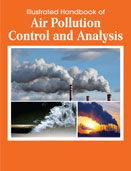Handbooks

It is very necessary to learn how to control air pollution because if we do not do then it is possible that air around us keeps on getting polluted. Ultimately a day may come when each one of us might be using oxygen cylinder to enjoy fresh air. This would add burden on our already high cost of living. Therefore, we should understand ways and means of air pollution control and analysis. This illustrated handbook is an essential reading for undergraduate and postgraduate students of Environmental Science and/ Engineering and provides an insight into the chemistry of air pollution. Different techniques are used for controlling air pollution caused by ?gaseous pollutants? and that caused by ?particulate pollutants?. The text also examines the methods that are applied to control and prevent environmental pollution.
The Earth?s atmosphere is a constantly moving body of gases that encircle our planet. This body of gases known as air is a mixture?not a chemical combination?of a number of gases; that is, each gas retains its own characteristic properties. It consists of about 78 percent nitrogen; about 21 percent oxygen, and carries along with it water vapor, clouds, dust, smoke, soot, and a variety of chemical compounds. The remaining one-percent contains all the other gases including carbon monoxide, carbon dioxide, ozone, methane, and ammonia that contribute to air pollution. Air pollution is one such form that refers to the contamination of the air, irrespective of indoors or outside. A physical, biological or chemical alteration to the air in the atmosphere can be termed as pollution. It occurs when any harmful gases, dust, smoke enters into the atmosphere and makes it difficult for plants, animals and humans to survive as the air becomes dirty. Smog hanging over cities is the most familiar and obvious form of air pollution. But there are different kinds of pollution?some visible, some invisible?that contribute to global warming. Generally any substance that people introduce into the atmosphere that has damaging effects on living things and the environment is considered air pollution.
Illustrated Handbook of Air Pollution Control and Analysis provides information for professionals attempting to reduce and eliminate air pollution problems. Modernization paved the way for new technologies. Innovation on transportation, lifestyle and almost everything around us is occurring every day.
However, it is our environment who is suffering from the comfort technology has brought us. Cars, factories and automobiles release hazardous gas causing air pollution that needs to be controlled. Because of the increase in demand of goods, the supply from manufacturing companies has to catch up. New factories are built so we can achieve self-sufficiency. These factories have become the major source of outdoor air pollution in urban areas and have been regulated to do air pollution control. The air coming from the factories contains substances known as air pollutants harmful to humans and the environment. Air pollution control techniques are employed to reduce or eliminate the emission into the atmosphere of substances that can harm the environment or human health. The control of air pollution is one of the principal areas of pollution control, along with wastewater treatment, solid-waste management, and hazardous-waste management. These include adverse effects on human health, property, and atmospheric visibility. The atmosphere is susceptible to pollution from natural sources as well as from human activities. Some natural phenomena, such as volcanic eruptions and forest fires, may have not only local and regional effects but also long-lasting global ones. Nevertheless, only pollution caused by human activities, such as industry and transportation, is subject to mitigation and control. The primary focus